Toyota Camry
Engine Spark Plugs Replacement Guide
How to check or change the engine spark
plugs in an XV50 7th generation 2012-2016 Toyota Camry with the 2AR-FE 2.5L motor.
By Paul B. Michaels Author & Photographer Auto Mechanic Since 1989 |
||
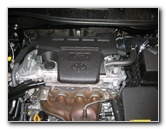 2013 Camry 2.5L I4 Engine |
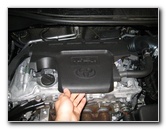 Pull Off Plastic Cover |
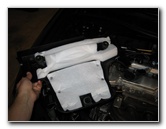 Engine Cover Removed |
| This
automotive "how-to" guide was specifically written to assist owners
of the XV50 7th generation (2012, 2013, 2014, 2015 & 2016)
Toyota Camry in checking or changing the engine spark plugs in the
2.5 liter inline four cylinder 2AR-FE motor. Owners of other Toyota, Scion or Lexus vehicles such as the Yaris, Corolla, Matrix, RAV4, Prius, Tacoma, Tundra, Sienna, FJ Cruiser, Venza, Highlander, Avalon, 4Runner, Land Runner, Sequoia, IS 250, ES 350, GS 350, tC, xB, xD, iQ and FR-S may also find these DIY instructions to be helpful. A few replacement spark plugs with their part numbers include the following: Denso SK16HR11 (Recommended OEM Iridium), Autolite XP5325 or APP5325, Champion REC12WMPB5, and Bosch FR8MII33X . The tools needed to complete this procedure include a 10mm socket with 1/4" drive ratcheting wrench, a 5/8" spark plug socket with a 6" extension bar, a 3/8" drive ratcheting wrench, dielectric "tune-up" grease, anti-seize lubricant (optional) and a spark plug gap gauge. |
||
|
|
||
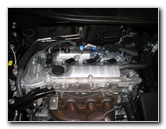 Spark Plug Wires Exposed |
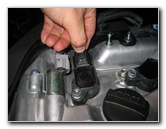 Press Release Tab |
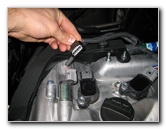 Slide Off Power Plug |
| The first step is
to lift off the plastic engine cover which is held in place by three friction
fasteners. If you have access to a can of compressed air or a wet/dry shop vacuum, thoroughly clean off the top of the engine to help reduce the chance of having debris drop in to the spark plug well. Press the release button on the power connector and slide it straight off the ignition coil. I'd recommend checking or replacing one spark plug at a time to further reduce the risk of dropping something in to the combustion cylinder. |
||
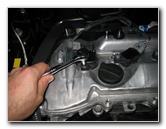 Loosen 10mm Bolt |
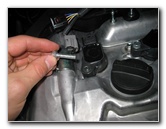 10mm Bolt Removed |
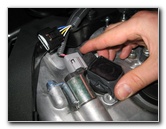 Rotate Ignition Coil |
| Loosen the single
bolt that holds the ignition coil in to place with the 10mm socket and
ratcheting wrench. Set the bolt aside in a safe place. Rotate the ignition coil back and forth a few times to ensure that the rubber dust boot is not stuck to the tip of the old spark plug. |
||
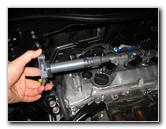 Pull Out Ignition Coil |
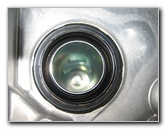 OEM Spark Plug In Cylinder |
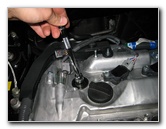 Attach Spark Plug Socket |
| Lift the ignition
coil straight out of the spark plug well and set it aside in a safe place. Attach the 5/8" spark plug socket to the 6" extension bar and lower it down over the top of the spark plug. |
||
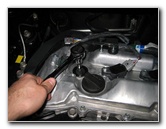 Loosen Old Spark Plug |
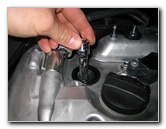 Spin Out Plug By Hand |
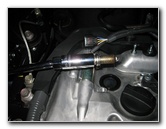 Lift Out Old Spark Plug |
| Attach the 3/8"
drive ratcheting wrench to the extension bar. Loosen the old spark plug by turning it counter clockwise. If the spark plug won't turn, spray in some penetrating oil such as PB Blaster, Liquid Wrench or Kano Kroil and wait 15-30 minutes or more before trying again. If you don't have any penetrating oil, try spraying some WD-40 or just warm up the engine for a few minutes to expand the metal engine block. Once the old spark plug is loose, detach the ratcheting wrench and spin it out by hand by turning the extension bar. Carefully lift the old spark plug straight up out of the well. |
||
|
|
||
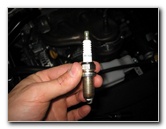 Denso SK16HR11 |
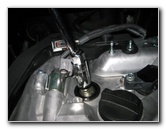 Lower In New Spark Plug |
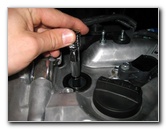 Spin In New Plug By Hand |
| Pull the old spark
plug out of the socket and inspect the electrode tip. The OEM spark plugs on
this 2013 Camry LE are Denso brand and part number
SK16HR11 (3417). If the end of the old spark plug looks ashy white, the plugs may have been exposed to high temperatures such as engine overheating or they are the incorrect heat range for your driving conditions and/or environment. If the old spark plugs are dark grey or covered in black soot, the engine may be burning oil and should be checked by a professional mechanic. The new iridium tipped spark plugs should be pre-gapped at 0.044" from the factory. It is still a good idea to check that the gap is correct using a spark plug gap gauge disc. If the gap is not very close to 0.044", exchange the plug for a new one. Insert the new spark plug in to the spark plug socket and make sure that the rubber insert or the magnet holds it securely. An optional step is to apply a small amount of anti-seize lubricant to the upper threads of the new spark plug. This will make the plugs easier to remove if they are not replaced again for another 100,000 miles. Do not get any anti-seize on the electrode at the bottom of the new spark plug. Some spark plug manufacturers recommend against using anti-seize. Carefully lower the new spark plug down in to the well while trying to avoid hitting the electrode tip on the cylinder block. Spin in the new spark plug by hand until it makes contact with the cylinder head to prevent it from becoming cross threaded. Attach the ratchet and carefully continue tightening the new plug until just past the point when you feel the crush washer at the top of the threads collapse. If you applied anti-seize lubricant to the threads, less force will be necessary to tighten the plugs. Do not over tighten the plugs to avoid cracking the ceramic part of the plug or stripping the aluminum threads in the cylinder head. |
||
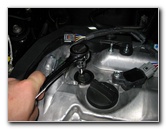 Attach Ratchet - Tighten Plug |
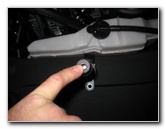 Dielectric Grease On Boot |
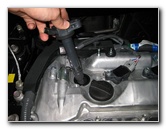 Insert Ignition Coil |
| Double check that
the new spark plug is tight before moving on to the next steps. Apply a small amount of dielectric grease to the opening of the rubber dust boot at the bottom of the ignition coil. This will help prevent it from becoming stuck to the tip of the new spark plug and keep out any moisture. Lower the ignition coil down over the tip of the new spark plug and rotate it a few times to help distribute the dielectric grease. |
||
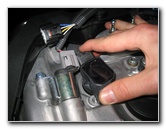 Rotate Coil - Spread Grease |
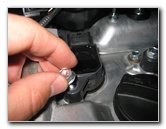 Replace 10mm Bolt |
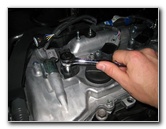 Tighten Ignition Coil Bolt |
| Re-insert the 10mm
bolt and spin it in by hand a few turns to prevent it from becoming cross
threaded. Tighten the bolt with the 10mm socket and ratcheting wrench. Do not over tighten the bolt to prevent from cracking the plastic ignition coil assembly. |
||
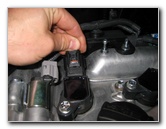 Push On Power Connector |
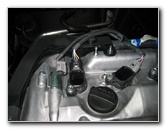 Spark Plug Replaced |
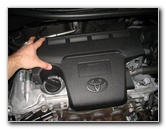 Push On Engine Cover |
| Push on the power
connector until it clicks securely in to place. Start the engine and listen for any strange sounds. If all goes well, push on the engine cover and close the hood to complete the job. Be sure to record the spark plug change in your vehicle's service records. For more,
check out my other
2012-2016 Toyota Camry DIY Repair & Maintenance Guides. |
||
| If you found this guide to be helpful,
please consider making a small donation by clicking on the PayPal.com
"Donate" button located to the right of this paragraph. Thank you!
(Note: I am not a registered charity. Donations are not tax deductible.) |

